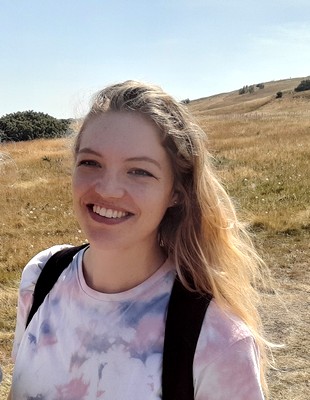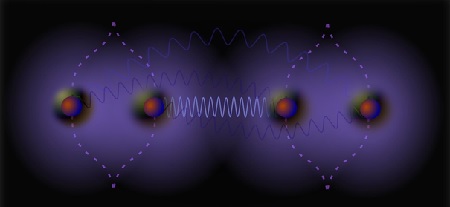Outreach prize for explanation of complex quantum phenomenon
Martine Schut, a PhD student at the University of Groningen, enjoys talking about her research at the intersection of mathematics and physics. She presents lectures in schools on Einstein’s relativity theory and this Friday (26 May) she received a price for a popular article that she wrote about an experiment that could prove that gravity is a quantum phenomenon.
‘All through my time at University, I have been involved in outreach events,’ says Martine Schut. ‘I want to make science accessible for everyone.’ In her case, it is mostly about mathematics and physics, although she was a co-founder of the Groningen branch of the JWG, a national astronomy association for young people aged 8 to 21 years. ‘Pre-corona, we had some 50 visitors at our meetings.’

Pluto
In 2020, she started a PhD project at the intersection of mathematics and physics. It involves an experiment that could prove that gravity obeys the laws of quantum mechanics. ‘There are four fundamental forces in physics, three of which are fully explained in terms of quantum mechanics. And while we do have a theoretical quantum description for gravity, the fourth fundamental force, there is no experimental proof as yet.’
If gravity is indeed a quantum phenomenon, it should be mediated by a particle, a graviton. Schut: ‘Since gravity is a very weak force, it is very difficult to prove the existence of such a particle.’ The standard technique to do this is to use a particle accelerator. That is how, for example, the Higgs particle was finally observed. ‘However, to detect gravitons, we would need an accelerator with a diameter as big as Pluto’s orbit around the Sun. So, this route is not possible,’ Schut explains.
Second prize
Therefore, she works on a different way of making the graviton visible, in an experiment that does not rely on the brute force of particle accelerators but on very subtle and strange quantum phenomena. She wrote an article about this experiment for the Dutch physics journal Nederlands tijdschrift voor Natuurkunde (NTvN), which organizes an annual competition for PhD students who want to explain their work to a wider audience. Schut won second prize with her description of the experiment to detect the graviton.

Entanglement
The experiment uses two quantum concepts: superposition and entanglement. Superposition means that a particle can be present at two locations at the same time. And entanglement means that two particles have opposite values, but it is not determined which values the particles have until one of them is measured. ‘If you have a red and a blue marble, you know one is red and the other is blue. However, with quantum particles, they don’t have any colour until you observe one. If that particle is red, the other particle will turn blue.’ What is special about this is that it happens even when both particles are far apart and no communication between them is possible.
Both superposition and entanglement are important for, among other things, the working of a quantum computer. In her NTvN article, Schut describes how they can be used to detect the exchange of a graviton between two quantum particles. This is all very subtle, since gravity is an extremely weak force. Schut explains just how weak it is: ‘If you want to reduce the electromagnetic force between the electron and the nucleus of a hydrogen atom to the strength of the gravity force between them, they should be separated by a distance as big as the size of the observable Universe.
Science Date
Her article describes the physics part of the experiment but Schut is also involved in its mathematical description. She is part of a group of PhD students who work in both fields and who are appointed to the Van Swinderen Institute for Particle Physics and Gravity, as well as the Bernoulli Institute for Mathematics, Computer Science and Artificial Intelligence. ‘Through the lens of mathematics, a quantum phenomenon such as entanglement is basically a knot. I use this to construct a mathematical description of entanglement.’ She expects to finish her PhD project next year and would like to continue research as a postdoctoral researcher. ‘I am already applying for a position.’ But she will also continue to explain her work to non-scientists. ‘My next venture in this is to be part of the University’s ‘Science Date Programme’ through which schools can book a guest lecture by a scientist.’
| Last modified: | 10 February 2025 09.11 a.m. |
More news
-
06 May 2025
Overcoming grid congestion: ‘Making better use of what we already have’
Grid congestion poses a major problem. There is little to no capacity to connect new households and businesses to the power grid and it risks halting the energy transition. Michele Cucuzzella, Associate Professor of Energy Systems & Nonlinear...
-
29 April 2025
Impact | Rubber recycling
In the coming weeks the nominees for the Ben Feringa Impact Award 2025 will introduce themselves and their impactful research or project. This week: Francesco Picchioni on his innovative way to recycle rubber.
-
29 April 2025
Impact | Improving Human-AI Decision-Making in healthcare
In the coming weeks the nominees for the Ben Feringa Impact Award 2025 will introduce themselves and their impactful research or project. This week: Andra Cristiana Minculescu on her research project on Human-AI Decision-Making in healthcare.

